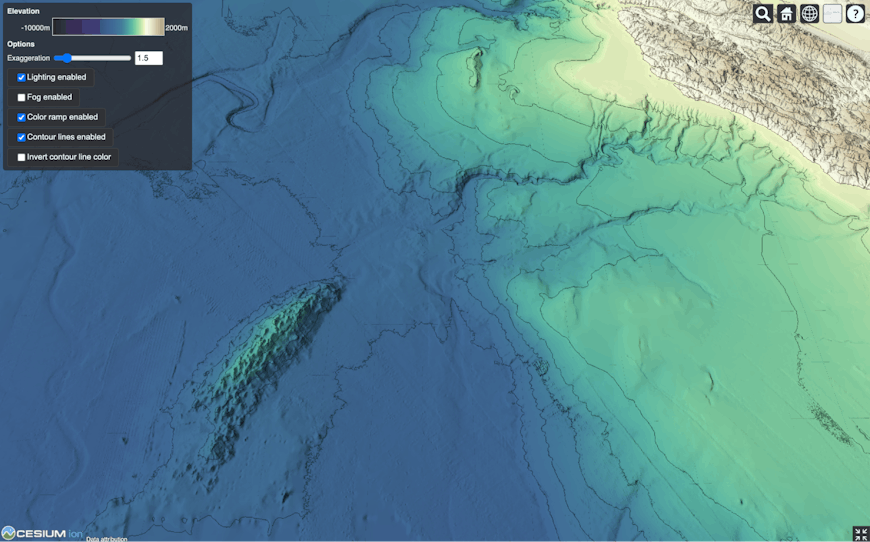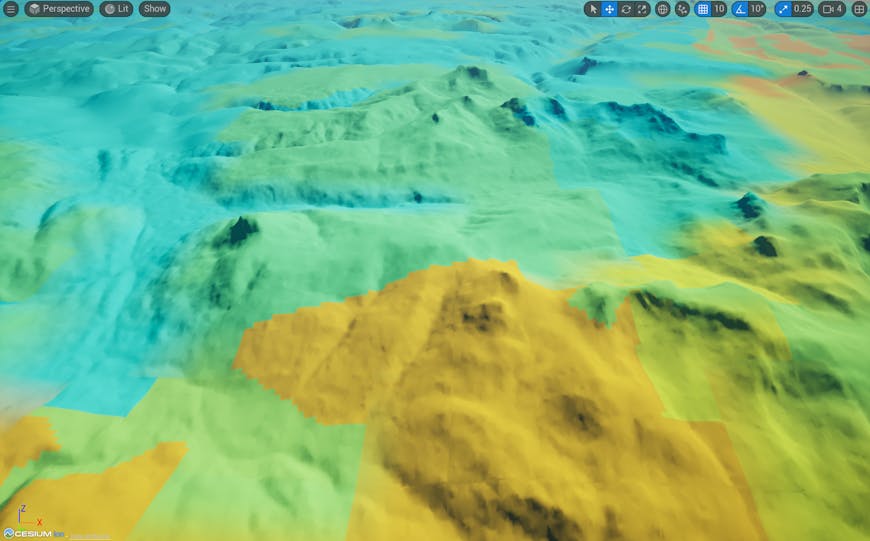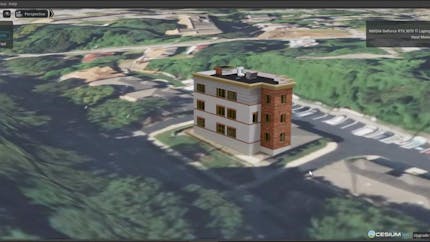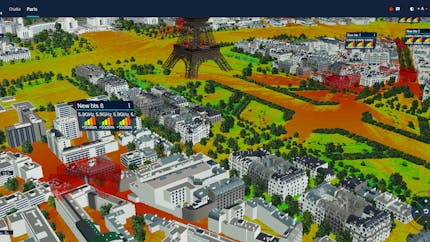Cesium Releases in February 2024
In January, we introduced Cesium World Bathymetry, a new global tileset that opens up visualization and analysis of underwater environments. You can explore some best practices to enhance the visualization of bathymetric terrain using CesiumJS.
Cesium World Bathymetry fuses multiple open data sources into a single bathymetry and topographic terrain tileset.
We made improvements across Cesium this month. To get notifications about our monthly releases, you can subscribe to the Cesium release roundup thread on our community forum.
CesiumJS 1.114 Release
CesiumJS 1.114 is now available. Highlights of the release include several improvements to interaction with 3D Tiles:
- By default, the screen space camera controller will no longer go inside or under instances of
Cesium3DTileset. #11581 - Clamping to ground,
HeightReference.CLAMP_TO_GROUND, andHeightReference.RELATIVE_TO_GROUNDnow take into account 3D Tilesets. #11604 - The
Cesium3DTileset.dynamicScreenSpaceErroroptimization is now enabled by default and tuned to improve performance for street-level horizon views. #11718 - Added
Cesium3DTileset.getHeightto sample height values of the loaded tiles. #11581 - Fog rendering now applies to glTF models and 3D Tiles. #11744
Other changes include:
- Added
createWorldBathymetryAsynchelper function to make it easier to load Bathymetry terrain. #11790 - Removed the need for node internal packages
http,https,url, andzlibin theResourceclass. This means they do not need to be marked external by build tools anymore. #11773 - Fixed an issue causing crashes with multiple data sources. #7758 and #9154
- Fixed a geometry displacement affecting iOS devices. #7100
For more details, see the changelog.

Cesium World Bathymetry off the coast of southern California, USA, with an elevation color ramp and contour lines in CesiumJS.
Cesium for Unreal 2.3.0 Release
Cesium for Unreal v2.3.0 is now available.
Highlights of this release include:
- Added support for Web Map Tile Service (WMTS) with
CesiumWebMapTileServiceRasterOverlay. - Significantly reduced CPU memory usage by textures on non-Windows systems.
- Added robust support for the
KHR_texture_transformglTF extension.
This release also includes a number of important bug fixes.
Check the Cesium for Unreal release and the Cesium for Unreal Samples release for the full list of updates.

WMTS layer draped over Cesium World Terrain in Cesium for Unreal. This WMTS is from Geoscience Australia: Sediment-Hosted Copper Mineral Potential Map (Model 1). In this screenshot, the camera is located in a mountainous part of Tasmania, Australia.
Cesium for Omniverse 0.17.0 Release
Cesium for Omniverse v0.17.0 is now available. Highlights of this release include:
- Several breaking changes for globe anchors, imagery layers, and tilesets. See the changelog for full details.
- Added support for polygon-based clipping with
CesiumPolygonRasterOverlay. - Added ability for multiple tilesets referencing the same raster overlay.
- Added ability to reorder raster overlays in UI.
- Added context menu options for adding raster overlays to tilesets.
- Fixed multiple globe anchor related issues.
- Fixed excessive property warnings when using custom materials.
- Fixed adding raster overlays to selected tileset in the Add Assets UI.
- Fixed loading 3D Tiles 1.1 implicit tilesets.
See the changelog for the full list of updates, and get started with our Cesium for Omniverse tutorials.
Tileset clipping in Cesium for Omniverse.

To modernize and manage facilities during architecture, engineering, construction, and operation (AECO), UrsaLeo builds custom digital twins and visualizes them in combination with Cesium for Omniverse.

Because 5G is powerful but sensitive, Blare Technologies uses CesiumJS to plan modern networks with real-world context.